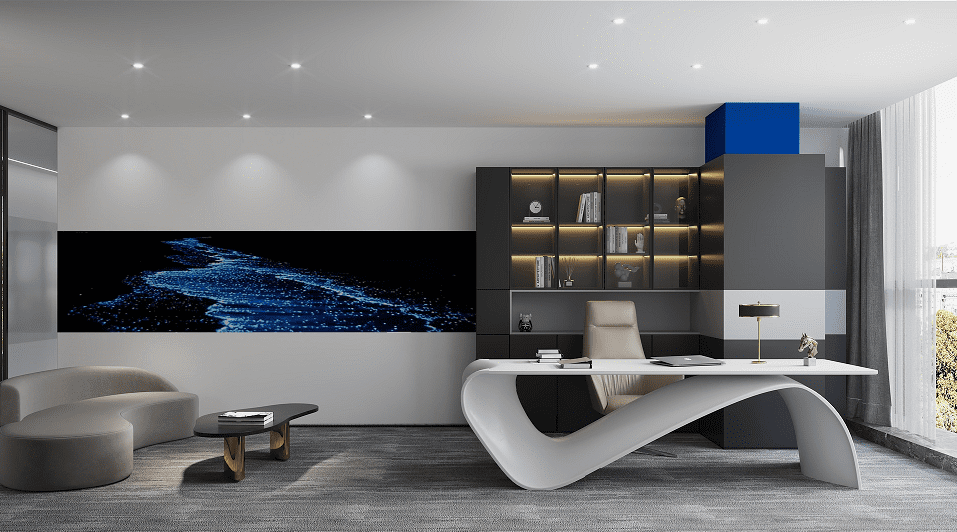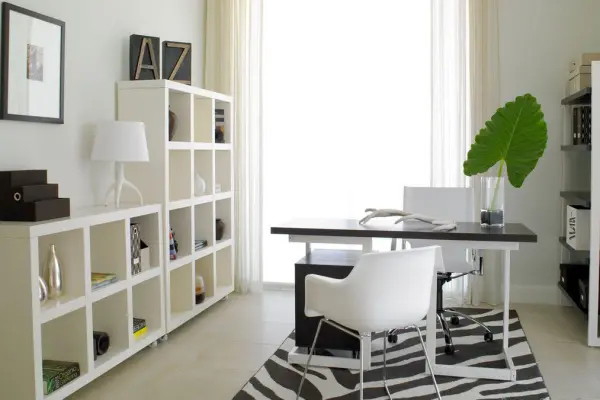Current Trends in Office Furniture Design
 The modern home office furniture market is actively developing under the influence of new technologies and lifestyle changes. Here are several current trends in office furniture design worth considering when choosing furnishings for your work corner:
The modern home office furniture market is actively developing under the influence of new technologies and lifestyle changes. Here are several current trends in office furniture design worth considering when choosing furnishings for your work corner:
- Vintage-inspired items are trending. In 2025, 30% of home offices use retro desks and chairs with modern elements, combining nostalgia with functionality.
- Bright colors enliven workspaces. Vibrant furniture in turquoise, mustard, or coral tones is gaining popularity, with 20% of home offices using colored chairs to improve mood and motivation.
- Sound-insulating furniture is gaining popularity. Chairs with noise-absorbing upholstery and tables with acoustic panels reduce background noise, which is ideal for virtual meetings.
- Eco-friendly office furniture is becoming standard. Items made from recycled materials or with sustainable production certification are in growing demand.
Furnishing a home office with these trends in mind will help create not only a functional but also a modern, stylish space that will correspond to current tendencies in interior design.
Features of Choosing Furniture for a Small Home Office
.jpeg) Organizing a workspace in a limited area presents a special challenge. A familiar problem, isn't it? How to place a full-fledged office where a computer desk barely fits? However, there are special solutions for optimizing office space in small premises:
Organizing a workspace in a limited area presents a special challenge. A familiar problem, isn't it? How to place a full-fledged office where a computer desk barely fits? However, there are special solutions for optimizing office space in small premises:
| Solution Type | Features | Space Saving |
|---|---|---|
| Folding tables | Easily put away when not in use | Up to 100% of table area |
| Wall-mounted fold-down desktops | Attached to the wall, lowered when needed | Up to 100% of table area |
| Corner computer desks | Use the corner space of the room | 25-30% compared to straight tables |
| Vertical storage systems | Use room height instead of area | Up to 70% of floor area |
| Multifunctional furniture | Combines several functions in one item | 40-60% of total area |
These solutions help to use limited space as efficiently as possible, creating a functional workspace even in a small apartment. Multifunctional furniture saves up to 20% of space, which is especially relevant for urban apartments smaller than 45 square meters.
The Influence of Materials on Office Furniture Quality and Durability
.png) Materials for office furniture determine not only appearance but also durability, functionality, and eco-friendliness of your workspace. Have you ever wondered why some work desks serve for decades, while others become unusable after just a couple of years? The secret is in the quality of materials! Home office design largely depends on properly selected materials. Here are several of the most popular options:
Materials for office furniture determine not only appearance but also durability, functionality, and eco-friendliness of your workspace. Have you ever wondered why some work desks serve for decades, while others become unusable after just a couple of years? The secret is in the quality of materials! Home office design largely depends on properly selected materials. Here are several of the most popular options:
- Natural wood — a classic material providing natural aesthetics and durability. Oak, walnut, maple, and cherry are especially popular.
- MDF and chipboard with laminated coating — an affordable alternative to natural wood, presenting a wide selection of colors and textures.
- Metal — often used for frames, legs, and accessories, providing strength and a contemporary look.
- Glass — applied for desktops and shelves, creates a feeling of lightness and visually enlarges space.
- Composite materials for desktops — combine strength and aesthetics of various materials.
According to market research, in 2024, wood and laminated materials constituted about 48.4% of the home office furniture market thanks to their strength and durability.
"When choosing materials for office furniture, it's important to consider not only aesthetics but also practicality. For example, for families with children, it's better to choose desktops from laminated MDF — they are resistant to scratches and easy to clean. And for those who value eco-friendliness, an excellent choice would be eco-friendly furniture materials from renewable sources," — advises Elena Petrova, an interior designer with 15 years of experience.
Economic Aspects of Choosing Home Office Furniture
When planning to purchase inexpensive home office furniture, it's important to consider not only the initial cost but also long-term investments:
Price-Quality Ratio
Although there may be a temptation to save money, it's important to remember that quality items, especially ergonomic chairs which can be bought in specialized stores, can serve for years and prevent health problems. And what will cost more — a quality chair now or spine treatment in the future?
Research shows that investments in anatomically correct furniture pay off through a 15% increase in productivity and a reduced risk of developing chronic musculoskeletal disorders. Home office furniture reviews confirm that comfort in the home office directly affects work results.
Purchase Options
There are several ways to acquire equipment for a home office:
- Purchasing new home office furniture in specialized stores or online shops
- Ordering custom office furniture according to individual dimensions (custom office furniture)
- Acquiring refurbished or used office furniture at office furniture sales
- Modernizing existing furniture to adapt it to office needs
Each of these options has its advantages and disadvantages depending on your needs, budget, and timeframe. Many manufacturers offer office furniture with a warranty, which becomes an additional argument in favor of choosing quality products.
Examples of Successful Home Office Setups of Different Sizes
For inspiration, let's consider several examples of successful workspace organization of various areas, avoiding common mistakes when choosing furniture:
Micro-Office (up to 5 sq. m)
Anna, a web designer from Barcelona, organized a compact workspace in a niche of her studio apartment. Key elements of her office:
- Wall-mounted fold-down desktop (space saving when not in use)
- Compact work seat with wheels
- Wall shelves and hanging organizers for storage
- Multifunctional lamp with adjustable brightness for proper home office lighting
"Even in such a small space, you can create a functional and comfortable workspace if you choose the right furniture for a small office," — shares Anna from her experience.
Medium Office (5-10 sq. m)
Michael, a financial analyst, designated a small room in his two-room apartment as a home office:
- Adjustable office desk for working sitting and standing
- Chair with back support
- Compact shelving for documents and books
- Mini relaxation zone with a comfortable reading chair
Large Office (more than 10 sq. m)
Elena, a freelance translator, transformed a free room into a full-fledged office, considering workspace psychology:
- Corner office desk with additional work surface
- Premium-class ergonomic seat
- Storage cabinets with open and closed sections
- Area for meeting clients with a small sofa and coffee table
- Sound-insulating panels for improving office acoustics
These examples show that regardless of available space, a competent approach to furniture selection and workspace organization allows for creating an effective home office.
Conclusion
Organizing a home office is not just about buying home office furniture but creating a space that promotes productivity and comfort. Isn't it amazing how a properly organized workspace can change your attitude towards work? Properly selected home office furniture not only reflects your professionalism but also contributes to maintaining health and well-being during work.
Remember that the global home office furniture market continues to grow, offering more and more innovative and ergonomic solutions. Regardless of whether you need a simple home computer desk or full equipment for a home workspace, it's important to consider both aesthetics and functionality.
Investments in quality home office furniture are investments in your health, comfort, and productivity. Are you ready to transform your workspace and experience how properly selected furniture can change your working life for the better? Create a workspace that will be not only effective but also an inspiring place for daily work.

